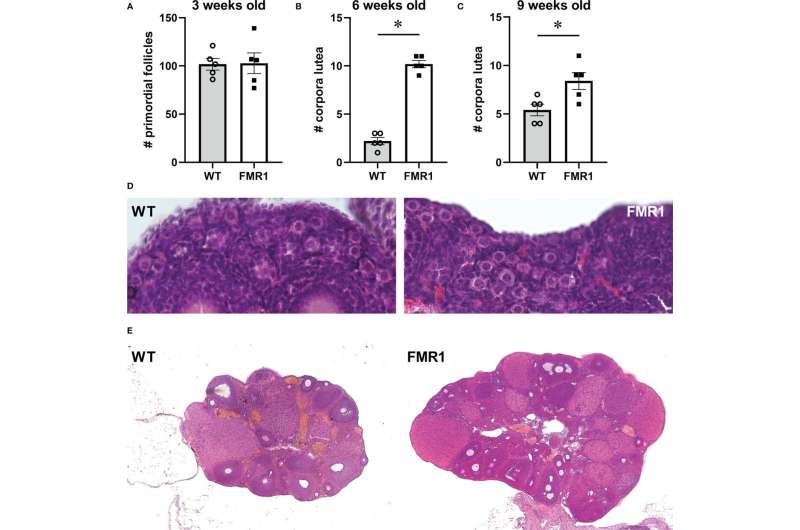This article has been reviewed according to Science X's editorial process and policies. Editors have highlighted the following attributes while ensuring the content's credibility:
fact-checked
trusted source
proofread
How an autism gene contributes to infertility

A University of California, Riverside, study has identified the biological underpinnings of a reproductive disorder caused by the mutation of a gene. This gene mutation also causes Fragile X Syndrome, a leading genetic cause of intellectual impairment and autism.
The researchers found mutations of the Fragile X messenger ribonucleoprotein 1 gene, or FMR1, contribute to premature ovarian failure, or POF, due to changes in neurons that regulate reproduction in the brain and ovaries. The mutation has been associated with early infertility, due to a 25-fold increased risk of POF, but the reasons were unclear.
POF is the most severe form of premature ovarian aging, which affects about 10% of women and is characterized by an early depletion of ovarian follicles and early menopause. With women postponing reproduction, the chances of infertility increase, including due to FMR1 mutation.
"In the last two or three decades, the median age of first-time mothers in the U.S. and Europe has steadily increased," said Djurdjica Coss, a professor of biomedical sciences in the UCR School of Medicine who led the research team.
"Moreover, premature menopause causes not only early infertility, but also increased risk of cardiovascular disease and osteoporosis. It's important, therefore, to understand the reasons behind these reproductive disorders and eventually find treatments. Such research can also help better advise women at risk on when to have a child and how to monitor their health outcomes."
According to the Centers for Disease Control and Prevention, 19% of heterosexual couples in the U.S. experience infertility and need assisted reproductive technology, which can be too costly for many couples.
Coss explained that previous studies concerning the FMR1-mediated reproductive disorders analyzed them exclusively from an endocrine perspective, meaning they studied the changes in hormone levels and how endocrine cells functioned in the ovaries that produce them.
"We took a different approach," Coss said. "Since the FMR1 gene is highly abundant in neurons, we postulated that neurons that regulate reproduction are affected by the FMR1 mutation, which in turn causes increases in hormone levels. Indeed, we found higher stimulation of neurons in the hypothalamus that regulate reproduction as well as more neurons in the ovaries that contribute to ovarian hormone synthesis."
To do the research, Coss and her team used transgenic mice that lack the FMR1 gene to emulate the condition in people with a mutation in this gene. They first determined that this mouse model mimics what is observed in women with a FMR1 mutation. They then compared the reproduction-regulating neurons in the ovaries and the brain between these mice and their normal counterparts.
They found the changes in function of these neurons led to a more rapid secretion of hormones in young transgenic female mice that later stopped reproducing early. Next, they removed the ovaries from these mice to determine the effect of the FMR1 mutation on just the neurons in the brain.
"This allowed us to determine that these neurons in the brain, called gonadotropin-releasing hormone neurons, show changes in connectivity that affect how they function," Coss said. "The increased number of synapses cause them to be faster and have more pulses of hormone secretion."
Her team also determined that neurons "innervating" the ovaries—supplying the ovaries with nerves—were more abundant in the transgenic mice than in their normal counterparts.
"We think the increases we see in ovarian hormone levels are due to increases in ovarian innervation rather than increases in hormone-producing cells," Coss said. "The endocrine perspective supports the latter."
Next, Coss and her team plan to investigate if the effects of FMR1 mutation can be alleviated by partially inhibiting neurons in the ovaries.
"We anticipate this may normalize ovarian hormone levels, possibly allowing for a normal reproductive lifespan," Coss said.
The research is published in the journal Frontiers in Endocrinology.
More information: Pedro A. Villa et al, Altered GnRH neuron and ovarian innervation characterize reproductive dysfunction linked to the Fragile X messenger ribonucleoprotein (Fmr1) gene mutation, Frontiers in Endocrinology (2023). DOI: 10.3389/fendo.2023.1129534




















